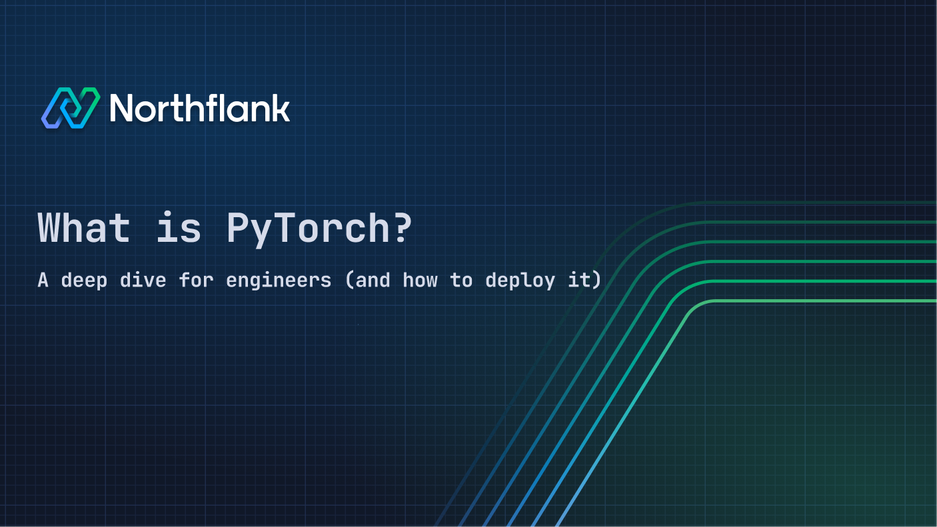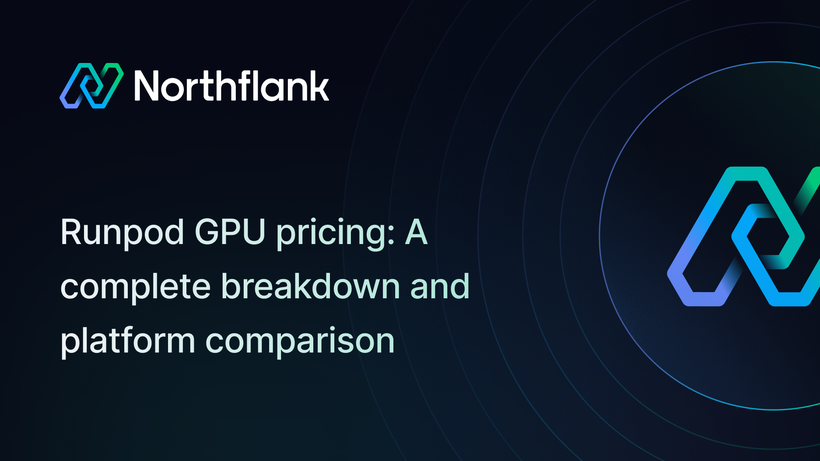

What is PyTorch? A deep dive for engineers (and how to deploy it)
Wondering what is PyTorch and why it’s become the deep learning framework of choice for modern AI systems? PyTorch is an open-source machine learning framework developed by Meta’s AI Research lab (FAIR). Since its release in 2016, it’s become a cornerstone of deep learning research and production-grade AI systems.
Engineers love PyTorch for its dynamic computation graphs, tight Python integration, and broad ecosystem. But most importantly, it lets you get work done without feeling like you’re constantly fighting the framework.
In this post, we’ll go beyond the standard “PyTorch is a deep learning framework” and unpack:
- What is Pytorch and why PyTorch is designed the way it is
- What makes it technically different from other frameworks
- Where it shines (and where it still hurts)
- How to reliably deploy PyTorch models using platforms Northflank, especially with GPU support and autoscaling
To really understand what is PyTorch and why it’s so widely used, we need to look at how it works under the hood.
Let’s dig in.
At the heart of PyTorch is its dynamic computation graph: a decision that fundamentally changes how you write, debug, and scale models. Unlike TensorFlow 1.x, which required pre-defining a static computation graph before execution, PyTorch lets you build graphs on the fly using regular Python control flow. This makes model development radically more flexible.
Here are examples showing the differences between the two:
PyTorch: Dynamic computation graph
import torch
x = torch.tensor(2.0, requires_grad=True)
y = x ** 2 + 3 * x + 1 # Computation happens as you write it
y.backward() # Triggers autograd
print(x.grad) # Outputs: tensor(7.)You can use if statements, loops, recursion, anything Python allows, because the graph is built dynamically at runtime.
TensorFlow 1.x: Static computation graph
import tensorflow as tf
x = tf.placeholder(tf.float32)
y = x**2 + 3*x + 1
grad = tf.gradients(y, x)
with tf.Session() as sess:
result = sess.run(grad, feed_dict={x: 2.0})
print(result) # Outputs: [7.0]You can’t just write a for loop or an if statement, you have to use TensorFlow's equivalents (tf.while_loop, tf.cond). Debugging becomes harder because the code you write isn’t the code that executes.
That difference changes how you approach model design altogether.
Want to build a recursive model that adjusts its architecture per input? Go for it. Training with branching logic, stochastic layers, or irregular tensor shapes? No problem. The dynamic graph is redefined on every forward pass, and PyTorch’s autograd engine keeps track of operations in real time to compute gradients during backpropagation.
This design choice matters. When you're debugging a model that isn't converging or a loss that's exploding, the last thing you want is to be buried under protobuf files or opaque static graph errors. In PyTorch, you can drop a breakpoint into your forward pass and inspect every tensor just like you would with NumPy. That level of introspection is a game-changer.
Under the hood, PyTorch wraps low-level CUDA/C++ ops in a clean Python interface and ships multiple hardware backends: CUDA for NVIDIA, MPS for Apple Silicon, ROCm for AMD, plus a solid CPU fallback. It handles tensor allocation, memory transfers, and kernel launches for you, but you can still drop down to torch.cuda.Stream, mps_sync(), manual gradient clipping, or fused kernels when you need to squeeze out more performance. The upshot: you can train models on an M1/M2 GPU today, something TensorFlow still can’t do without workarounds.
The autograd system is built on a tape-based mechanism: as operations are performed on tensors with requires_grad=True, PyTorch records them in a DAG. When you call .backward(), it walks the graph in reverse, computing gradients via the chain rule. This means PyTorch doesn’t require symbolic differentiation, just real Python execution.
import torch
# Create tensors with gradient tracking
x = torch.tensor([2.0], requires_grad=True)
y = torch.tensor([3.0], requires_grad=True)
# Forward pass - PyTorch builds the computation graph
z = x * y + x**2 # z = 2*3 + 2^2 = 10
# Backward pass - compute gradients
z.backward()
print(f"dz/dx = {x.grad}") # Output: dz/dx = tensor([7.])
print(f"dz/dy = {y.grad}") # Output: dz/dy = tensor([2.])For performance, PyTorch uses custom C++ backends and ATen (its tensor library) along with CuDNN kernels under the hood. As a result, you get performance comparable to low-level CUDA code with a much simpler development experience.
One of the most common follow-up questions to “what is PyTorch” is: how do you move from research to production? That’s where TorchScript comes in.
Any answer to the question “what is PyTorch used for in the real world” should start with where it dominates: research labs and large-scale production systems.
Every major ML lab (OpenAI, DeepMind, Meta, NVIDIA) uses PyTorch. It powers everything from diffusion models and LLMs to recommender systems and robotics. This widespread adoption isn’t accidental.
- Ecosystem depth: PyTorch has best-in-class libraries for vision (TorchVision) and speech (TorchAudio). While TorchText (for NLP) is no longer in active development, the ecosystem includes many third-party libraries like Transformers (Hugging Face) for language tasks, plus a rich third-party ecosystem including PyTorch Geometric for graph learning.
- Distributed support: DDP (Distributed Data Parallel) is tightly integrated and efficient. FSDP (Fully Sharded Data Parallel) allows model parallelism and parameter sharding.
- Mixed precision: AMP (Automatic Mixed Precision) helps accelerate training while reducing memory usage, especially on A100s and H100s.
- Multi-backend support: PyTorch has granular GPU control across multiple backends including CUDA (NVIDIA), ROCm (AMD), and Metal (Apple Silicon), plus supports custom extensions for specialized hardware.
- Developer velocity: You can debug with native Python tools, test hypotheses quickly, and iterate faster than static-graph-based frameworks.
It also doesn’t hurt that Hugging Face’s entire model hub is PyTorch-first. Most pretrained models you want (BERT, GPT, CLIP, Stable Diffusion) come with PyTorch weights and from_pretrained() support out of the box.
from transformers import pipeline
# Load a pretrained sentiment analysis model
classifier = pipeline("sentiment-analysis")
# Run inference
result = classifier("PyTorch makes deep learning accessible!")
print(result) # [{'label': 'POSITIVE', 'score': 0.999}]Check out how to install Pytorch here
Let’s say you’ve trained a 300MB model that segments satellite imagery for environmental monitoring. It works brilliantly in your notebook. Now what?
You need to:
- Write a serving layer (FastAPI, Flask)
- Dockerize it
- Configure GPU runtime and drivers
- Set up request queuing and autoscaling
- Deal with CI/CD and versioned rollouts
- Monitor latency, error rates, GPU utilization
- Add secrets, config, security, maybe OAuth
Even worse, you’ll spend days wrestling with IAM roles, container registries, VPCs, ingress controllers, and logs that go nowhere useful. This is no longer ML engineering, it’s DevOps trench warfare.
Most teams duct tape together AWS Lambda, ECS, Terraform, and homegrown CI pipelines.
The result is fragile infra, painful deploys, and no visibility. PyTorch itself didn’t get you into this mess. But it’s not getting you out of it either.
Northflank turns that deployment mess into something clean, fast, and repeatable. It’s a PaaS built for containerized workloads, with first-class support for GPUs, Git-based CI/CD, secrets management, and autoscaling.
Here’s how PyTorch deployment works on Northflank:
- Wrap your model in a server (FastAPI, Flask, or… you choose)
- Write a Dockerfile with your app, model weights, and dependencies
- Push your code to GitHub
- Connect it to Northflank via Git integration
- Enable GPU workload (H100, A100, or CPU-only)
- Set autoscaling parameters and deploy
No need for YAML. No need for Helm charts. No need to know what kubectl get pods means.
Under the hood, Northflank provisions container workloads with real-time logs, runtime metrics, secrets injection, persistent storage, custom domains, and fine-grained environment configs.
You can:
- Set per-branch deployment rules (e.g., deploy staging from
develop, prod frommain) - Use service discovery for internal APIs
- Deploy sidecars or job workers
- Roll back instantly if a deploy fails
And yes, you can deploy on GPUs using providers like CoreWeave. If you're running a PyTorch model that needs CUDA, you toggle GPU and you're done. No NVIDIA driver installs. No container hacks.
Say you’ve trained a ResNet-50 model on ImageNet and want to expose it via an HTTP API.
Your inference.py might look like:
from fastapi import FastAPI, UploadFile
import torch
from torchvision import transforms
from torchvision.models import resnet50, ResNet50_Weights
from PIL import Image
import io
model = resnet50(weights=ResNet50_Weights.DEFAULT)
model.eval()
app = FastAPI()
transform = transforms.Compose([
transforms.Resize(256),
transforms.CenterCrop(224),
transforms.ToTensor(),
transforms.Normalize(mean=[0.485, 0.456, 0.406], std=[0.229, 0.224, 0.225])
])
@app.post("/predict")
async def predict(file: UploadFile):
image = Image.open(io.BytesIO(await file.read())).convert("RGB")
tensor = transform(image).unsqueeze(0)
with torch.no_grad():
logits = model(tensor)
pred = torch.argmax(logits, dim=1).item()
return {"prediction": pred}Your Dockerfile:
FROM python:3.12-slim
WORKDIR /app
COPY . .
RUN pip install torch torchvision fastapi uvicorn pillow python-multipart
CMD ["uvicorn", "inference:app", "--host", "0.0.0.0", "--port", "8080"]Push this to GitHub. On Northflank:
- Create a new service
- Connect your repo
- Enable GPU workload
- Set autoscaling and memory limits
- Deploy
Your model is now accessible at a custom URL with real-time logging, GPU metrics, and deploy history. Need to update weights? Push to your branch and Northflank rebuilds automatically.
You can also deploy multi-model APIs, A/B test model versions, and run async job queues with GPU-backed workers. Northflank supports both persistent services and job-type workloads, so you can:
- Batch-process inference jobs
- Schedule retraining pipelines
- Serve multiple models behind one FastAPI interface
- Store model artifacts in object storage and fetch them at runtime
For ML teams operating in hybrid environments (e.g., some models on GPU, others CPU), Northflank gives granular resource control per service.
PyTorch is one of the most important tools in modern AI. It made model development intuitive, flexible, and fast. But for all its strengths, it leaves a gaping hole when it comes to production infrastructure.
Northflank is the missing link. It takes everything painful about PyTorch deployment (containers, GPUs, autoscaling, CI/CD) and makes it click.
If you're building serious ML systems and want infra that works with you, not against you, give Northflank a spin. It won’t train your model, but it’ll run the hell out of it.


